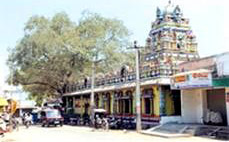 The temple is a perfect blend of Chalukya and the Chola styles of temple architecture. There is a wealth of inscriptions on the walls. The epigraphy on the walls is perhaps the richest among all the temples here. There are 381 inscriptions from Saka 1002 (1080 AD) to Saka 1356 (1434 AD). There are inscriptions of eastern Chalukyan kings, western Chalukyan kings, the Chola and Kalinga kings and queens, in addition to innumerable votive offerings of their own ministers and generals.
The temple is a perfect blend of Chalukya and the Chola styles of temple architecture. There is a wealth of inscriptions on the walls. The epigraphy on the walls is perhaps the richest among all the temples here. There are 381 inscriptions from Saka 1002 (1080 AD) to Saka 1356 (1434 AD). There are inscriptions of eastern Chalukyan kings, western Chalukyan kings, the Chola and Kalinga kings and queens, in addition to innumerable votive offerings of their own ministers and generals.
The vimana over the main garbha griha with its horizontal motif, and an octagonal one is a good specimen of the Dravida type of temple architecture. The western gopura has seven stories, and is of Chola origin. There are beautiful pillared mantapas all round. In the Mukha Mantapa, there are pillars with scenes sculptured and are of Chalukyan origin. There is a small `model temple` made out of a single stone, and built exactly like the original temple. At the main entrance there is an image of Ganesha. There is a Navagraha shrine and Ashta Dikpalakas shrine in the eastern mukhamantapa. There is a temple dedicated to Vigraham Sri Lakshmi Narayana Swami and is said to have been installed by Sri Ramachandra as the Kshetrapalaka. It is believed a Divya Sthala becomes a Punya Sthala, only when there is a Vishnu image in the Sivalaya, and a Siva image in the Vishnalaya.
Legend: The name Draksharama is corrupted form of `Draksharama - garden of Drakshaprajapathi. The place is associated with the puranic legend of Dakshaprajapathi`s Yagna. Dakshaprajapathi`s daughter Dakshayani (Sati) married Lord Shiva. One day he decided to perform a yagna, to which, he did not invite Lord Siva. Dakshayani was anxious to attend this yagna, but could not do it openly, but she resolved to attend the yagna anyway. Dakshaprajapathi`s pride increased. In his extreme pride, he did not receive his own daughter properly, nor did he acknowledge her, with her self-respect wounded, she plunged into the yagya fire itself, and ended her life.
Lord Siva, hearing the news, became furious and began to sweat, out of this sweat, was born Veerabhadra, who killed Drakshaprajapathi, and avenged the insult to Lord Siva. Draksharama is said to be the seat of the famous yagna and orthodox Brahmins do not perform any yagna within the temple premises.
Another legend states Lord Siva is worshipped in Lingakara. The shape of the Mula Virat is a long cylindrical pillars some 20 or 25 feet high, five pieces fell at five different places or Aramas - Bheemarama or Bheemavaram in Kakinada, Ksheerarama or Palakollu in West Godavari, Amararama or Amaravati in Guntur, Daksharma or Draksharama in East Godavari and Kurmarama, which is Kotipalli in East Godavari District. The original lingam was originally erected by the Sun god himself, and worshipped by the seven sages present as the seven branches of the Godavari. The rishis - Kasyapa or Tulya, Atri, Gowtama, Bharadwaja, Kousika or Vishwamitra, Jamadagni and Vasishtba.
The Bharadwaja, Vishwamitra and Jamadagni Godavaris are no longer in existence but the other branches remain. The seven sages brought the waters from their respective rivers here and are called Sapta-Godavari-Tirtha. It is customary for pilgrims to undertake a bath in these seven Godavaris or the Saptasagara Yatra that confer liberation.
The third legend about these temples is that the temple was originally a Buddha Chaitya and that during the course of the revival of Hindu worship, it was converted into a Hindu temple.
Draksharama is also called Dakshina Kasi or Banaras of the south. Vedavyasa founded this temple, and the Ravi tree and Lingam, which can still be seen here. Within the temple is a well, the mouth is shaped like a strung bow and is called the Rudra Tirtha and a lingam at the western gate is equivalent to making a daily pilgrimage to Banaras. There are many popular legends and Sthalapuranas regarding the sanctity and sacredness of this place. In the Saptogodavari, Lord Siva himself manifested himself in the form of a linga, called Bhimeswara Swami.











